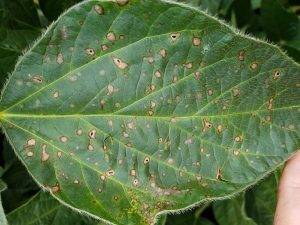
Frogeye leaf spot is a foliar disease caused by the fungus Cerospora sojina. The fungus primarily spreads from infected plants through air and water droplets. During particularly wet years, frogeye leaf spot can lead to yield loss as high as 30%.
Warm, humid weather and heavy rainfall are key drivers of frogeye leaf spot. Areas with standing water and high moisture are notorious for hosting the fungus and fuel the damaging disease. Soybeans grown year after year in the same field are also more susceptible to frogeye.
Scouting for Frogeye
Frogeye leaf spot most often infects plants after flowering, and signs are most evident in the upper canopy of plants. Dark spots with a gray center and a red-purple border will form on infected eaves. The smaller spots can join to create larger lesions, leading to defoliation that can reduce photosynthetic leaf area.
In addition to causing defoliation, frogeye leaf spot often leads to premature leaf drop. The disease can also infect stems and pods. Later in the growing season, reddish-brown lesions will form on stems and turn the centers of the stems gray. Gray or brown cracked seeds can also form as a result of the disease and pods will be discolored with long lesions.
Treatment Options
Selecting varieties with resistance to frogeye leaf spot is the best way to prevent the disease. As the fungus Cerospora sojina is able to overwinter, tillage practices that reduce weeds and bury residue will decrease the likelihood of future infection.
Fungicide application for treating frogeye leaf spot is most effective between the R2 and R5 growth stages. Be sure to consult with your local Latham representative to determine the best strategy for managing frogeye leaf spot.
